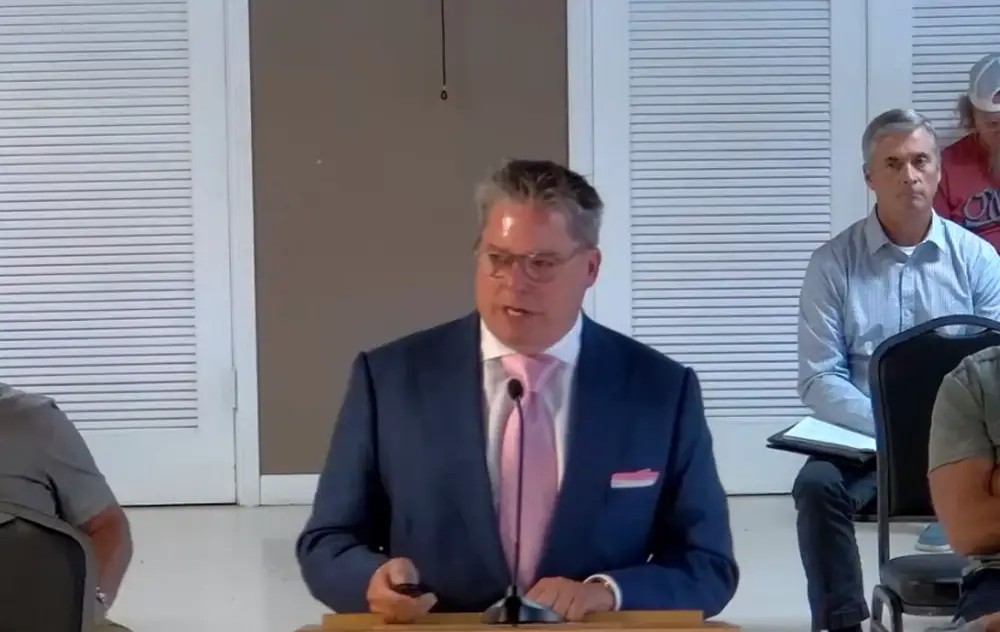
L. Carson Bise, president of the consultancy Flagler Beach government hired to prepare a study proposing a 90 percent increase in the city’s impact fees levied on builders, on Wednesday responded point by point to questions and criticism of the study by the executive officer of the Flagler Home Builders Association, a day before the city commission is expected to vote on the proposal. Not all the responses appear entirely tenable.
Impact fees are one-time levies on builders and developers of homes and commercial properties, essentially a one-time tax whose revenue is specifically appropriated to infrastructure that helps defray the “impact” of growth. The levy is imposed exclusively on new properties, not on existing homes selling to new owners. Homeowners don;t see impact fees listed in their costs, but the pass-through cost is reflected in the overall price of a home.
Flagler Beach has water and sewer impact fees, but hasn’t raised them since 2012. The study proposes a 22 percent increase in those fees, to a combined $6,813, an amount still less than what it would have been–$7,656–had the impact fees been indexed to inflation since 2012. Flagler Beach has never had parks, fire, police, library and transportation impact fees. It is now proposing to add those to the schedule, so the total amount of impact fees would rise from $5,592 to $10,648, not including transportation fees (those have yet to be calculated.)
The impact fee study was conducted by TischlerBise, a Bethesda-based consultancy and a leading firm in the business of impact fee studies. It has conducted such studies for the local school board and Palm Coast, among others. The studies are required before local governments impose new fees or raise existing ones, since those fees must be based on provable rationales. Studies typically draw criticism from elected officials or organizations generally opposed to impact fees, or at least not thrilled by them, among them business groups, chambers or commerce, builders, developers and the attorneys representing them.
Annamaria Long, the executive officer of the Flagler Home Builders Association, earlier this month signed off on Palm Coast’s 30 percent increase in water and sewer impact fees over the next four years, muting opposition. “While it is often believed that we oppose all impact fees, I would like to first clarify that we are not opposed to reasonable impact fees that can be upheld to the promise made upon their collection,” Long wrote the Flagler Beach City Commission and City Manager Dale Martin on Tuesday, referring to the promise that impact fees “will be used only for new growth, never for operations, maintenance, replacement or correcting existing deficiencies.”
But Long, who grew up in Flagler Beach, was not as forbearing toward the Flagler Beach proposal, listing a series of “mathematical errors” and more than a half dozen concerns, some of which were noted in yesterday’s article here. Long chose specifically to send her analysis to the commission rather than to Bise “because the mathematical errors I’ve come across are simple math that they will likely charge The City of Flagler Beach more money to correct.” The commission approved a not-to-exceed $49,120 contract with the consultant in March 2022. (Bise last July said the study was “dead in the water,” during the administration of the previous city manager, until acting manager Mike Abels “revived” it.)
The city manager conveyed Long’s analysis to Bise, and Bise responded, starting with a refutation of the claim that the study contained numerous mathematical errors. “We can assure you the calculations are correct,” Bise said in his response, citing one typo and adding a disclaimer that should have been part of the original study–a disclaimer that essentially explains that figures are rounded.
Long’s “main concern” had been the study’s inclusion of Veranda Bay, a development that would have up to 2,700 housing units at build-out, in its calculations, even though Veranda Bay is currently on county land, not in the city limits. The Veranda Bay developer has indicated interest in annexing into the city, a move the city is urging on him. If there is no annexation, Bise said, “this has no bearing on the actual non-utility impact fee calculations since the incremental expansion methodology was used. Further, it is our understanding that the City will be utility provider for Veranda Bay and will assess this fee regardless of the development being inside or outside of the City.” (Utility impact fees are levied by the government providing the utilities regardless of municipal boundaries.)
Long was critical of the study’s use of demands on police services on a per-capita basis, and correctly noted that it is now a more controversial than accepted way of calculating those demands: many factors contribute to demands for that service aside from population numbers. For example, an older population will make more demands on EMS services but fewer demands on police services. The nature of police calls in a beach community are vastly different from those of an urban core. Seasonal and tourist numbers can skew population totals. The Flagler County Sheriff’s Office has moved away from mere population ratios, opting for call ratios.
“It is standard practice for police and fire impact fees to use either calls for service or functional population to derive proportionate share factors,” Bise responded. “It has been our experience that either method typically derives similar percentages.” It was an odd and more likely inaccurate claim in light of such studies as the International City/County Management Association (an analysis of 62 police agencies’ staffing methods), which finds workload ratios more accurate than population ratios and cautions against “antiquated and unreliable methods to make one of the most financially important and critical decisions” facing local communities. The Center for Public Safety management, a co-signer on the study, in one of its own, earlier white papers pit it explicitly: “Officers per thousand and other deployment myths,” and “Officers Per Thousand IS NOT a Standard!”
Bise is standing by the study’s arresting conclusion, based on population ratios, that the Flagler Beach Police Department will need 46 police in only nine years. Bise says that will be necessary in light of Veranda Bay increasing the city’s population by 93 percent. But that increase is nowhere yet determined by such a tight timeline.
Long and Bise also disagreed over the size of future fire department building needs, and what amounts to proper or improper “amenities” that may be bought with impact fee dollars. Some of Long’s claims went far afield, as when she said that certain planned developments, presumably with Veranda Bay in mind, “typically supply their own amenities for their residents.”
“That is completely irrelevant to the impact fee study,” Bise retorted. “There is no guarantee these residents will not utilize Citywide parks and improvements. Impact fees are for system improvements. This is like saying I shouldn’t pay a park impact fee because my house has a pool and a basketball goal.”
![]()
Original documentation: see the emails by Carson Bise and Annamaria Long in their full context here.










